Technology
PROPERTY| ROTATIONAL MOULDING
Rotational molding is an atmospheric pressure process that produces nearly stress-free parts. The fact that there are no stresses on the melt as it is shaped is a major advantage that rotational molding has over all other manufacturing methods for plastics parts. Also, as there are no forces on the plastic melt during forming, rotational molds can have thin walls and are relatively inexpensive to fabricate. For simple parts, mold delivery times can be a few days or weeks. Modern, multi-armed machines allow multiple molds of different sizes and shapes to be run at the same time. With proper mold design, complex parts, such as double-walled containers, that are difficult or impossible to mold by any other method, can be rotationally molded. With correct process control, the wall thickness of rotationally molded parts is quite uniform, unlike structural blow molding or twin-sheet thermoforming.
DISTORTION
Some of the main limitations are regarding the minimum distance between walls, in order to allow the material to flow freely to the more remote zones of the mould and the need to avoid acute internal angles less than approx 45°, where the thickness could decrease to an unacceptable degree. As with other moulding processes, it is better to follow all the usual rules regarding the size of radiuses, the requirement for draft, and stiffenings ribs. Moderate undercuts can be produced by slightly distorting the moulded part as it is removed from the mould.
